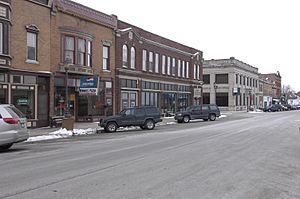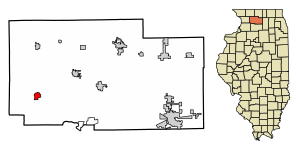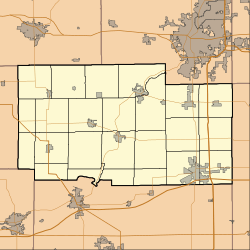Polo, Illinois facts for kids
Quick facts for kids
Polo
|
|||
|---|---|---|---|

Downtown Polo
|
|||
|
|||
| Motto(s):
Gateway to the Pines
|
|||

Location of Polo in Ogle County, Illinois.
|
|||
| Country | United States | ||
| State | Illinois | ||
| County | Ogle | ||
| Township | Buffalo | ||
| Area | |||
| • Total | 1.45 sq mi (3.76 km2) | ||
| • Land | 1.45 sq mi (3.76 km2) | ||
| • Water | 0.00 sq mi (0.00 km2) | ||
| Elevation | 863 ft (263 m) | ||
| Population
(2020)
|
|||
| • Total | 2,291 | ||
| • Density | 1,578.91/sq mi (609.44/km2) | ||
| Time zone | UTC-6 (CST) | ||
| • Summer (DST) | UTC-5 (CDT) | ||
| Postal code |
61064
|
||
| Area code(s) | 815 | ||
| FIPS code | 17-60937 | ||
Polo is a city located in Ogle County, Illinois, United States. It is often called the "Gateway to the Pines." In 2020, about 2,291 people lived in Polo.
Contents
A Look Back: Polo's History
The city of Polo got its name from the famous explorer, Marco Polo. It officially became a city on February 16, 1857. That's over 160 years ago!
Where is Polo?
Polo is located in northern Illinois. You can find it at these coordinates: 41°59′13″N 89°34′38″W / 41.98694°N 89.57722°W.
The city covers a total area of about 1.36 square miles (3.52 square kilometers). All of this area is land, with no large bodies of water inside the city limits.
Who Lives in Polo?
Polo has seen its population change over the years. Here's how the number of people living in Polo has grown and shrunk:
| Historical population | |||
|---|---|---|---|
| Census | Pop. | %± | |
| 1870 | 1,805 | — | |
| 1880 | 1,819 | 0.8% | |
| 1890 | 1,728 | −5.0% | |
| 1900 | 1,869 | 8.2% | |
| 1910 | 1,828 | −2.2% | |
| 1920 | 1,867 | 2.1% | |
| 1930 | 1,871 | 0.2% | |
| 1940 | 2,071 | 10.7% | |
| 1950 | 2,242 | 8.3% | |
| 1960 | 2,552 | 13.8% | |
| 1970 | 2,542 | −0.4% | |
| 1980 | 2,643 | 4.0% | |
| 1990 | 2,514 | −4.9% | |
| 2000 | 2,477 | −1.5% | |
| 2010 | 2,355 | −4.9% | |
| 2020 | 2,291 | −2.7% | |
| U.S. Decennial Census | |||
In 2000, there were 2,477 people living in Polo. Most people living in Polo are White. A small number of people are from other racial backgrounds. About 1.57% of the population identified as Hispanic or Latino.
Many families live in Polo. In 2000, about 31.3% of households had children under 18 living with them. The average household had about 2.4 people. The average family had about 3 people.
The median age in Polo in 2000 was 40 years old. This means half the people were younger than 40 and half were older. About 25.1% of the population was under 18 years old.
Learning in Polo
Polo has its own school district, called Polo School District 222. This district includes several schools for different age groups:
- Polo Community High School
- Aplington Middle School (for grades 6 to 8)
- Centennial Elementary School (for Preschool to 5th grade)
There is also Christ Lutheran School, located in nearby Sterling. This school serves students from Polo and other nearby towns. It teaches students from age 3 through 8th grade. The school focuses on core subjects like math and reading, while also teaching based on the Bible.
Polo Public Library
The Polo Public Library is a special place for books and learning. It is located at 302 West Mason Street. The library is run by the Polo Public Library District.
The library building is a historic site. It is one of several Carnegie libraries listed on the National Register of Historic Places. These libraries were built with money from Andrew Carnegie. The Polo library started in 1871 as a club where members paid a fee. In 1891, it became a free public library for everyone in the town.
Famous People from Polo
Some notable people have come from Polo, Illinois:
- George Perkins Clinton (1867–1937), a scientist who studied plants and fungi.
- George Peek, an economist who studied money and trade.
- Kathleen Weaver, a writer and editor.
See also
 In Spanish: Polo (Illinois) para niños
In Spanish: Polo (Illinois) para niños





